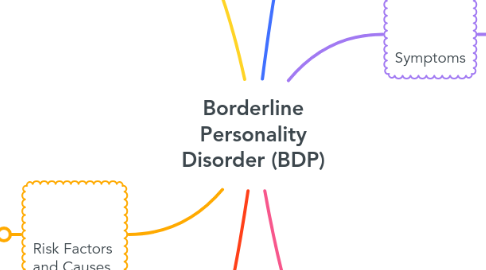
1. Recent Research (studies)
1.1. "Borderline Personality Disorder and Social Connectedness: *A Systematic Review" *
1.1.1. Research demonstrates strong correlations between BPD and social connectedness variables.
1.1.1.1. While research indicates that individuals with BPD and prominent BPD traits crave connection, they often experience isolation, characterized by small social networks, lower relationship satisfaction, and heightened feelings of loneliness and nonacceptance.
1.2. "Borderline Personality Disorder Stigma: *Examining the Effects of Diagnostic Disclosure, Behavior, and Gender as Sources of Stigma in the General Population" *
1.2.1. There currently exists greater amounts of stigma for BDP than the diagnostic labelling of the disorder.
1.2.1.1. It was discovered that gender interacts with BPD stigma in a number of ways and is in accordance with broader gender stereotypes
2. Risk Factors and Causes
2.1. Genetic, environmental and social factors may increase the possibility of developing BDP
2.1.1. Family History
2.1.1.1. Individuals with close relatives who have BDP are more likely to develop the disorder due to genetic factors.
2.1.2. Brain Structure and Function
2.1.2.1. People with BDP may have structural and functional changes in the brain, specifically in motor control and emotional regulation.
2.1.3. Environmental, Cultural, and Social Factors
2.1.3.1. Victims of BDP report having experienced traumatic events in the past. By contrast, others may have experienced unstable, tumultuous relationships or conflicts.
3. What is it?
3.1. Borderline Personality Disorder is a mental illness that heavily hinders a victim's ability to regulate their own emotions. These irregularities raises impulsivity and disturbs self-recognition. It is characterized by instability in interpersonal relationships, self imaging, and mood.
4. Prevalence
4.1. Borderline Personality Disorder affects approximately 0.7% to 2.7% of adults and is associated with functional deficiencies and greater use of medical services.
5. Symptoms
5.1. Desperate attempts to avoid abandonment.
5.2. Intense and unstable relationships
5.3. A distorted and unstable self-image.
5.4. Impulsive and risky behaviors like spending sprees, unsafe sex, substance abuse, reckless driving, and binge eating.
5.5. Self-harming behaviors, like cutting.
5.6. Recurring thoughts of suicide or threats.
5.7. Chronic feelings of emptiness.
6. Treatments
6.1. Psychotherapy
6.1.1. Dialectical behavior therapy (DBT)
6.1.1.1. Uses concepts of mindfulness or awareness of one’s present situation and emotional state while also teaching how to regulate behaviors and relationships.
6.1.2. Cognitive behavioral therapy (CBT)
6.1.2.1. Helps identify and change beliefs and behaviors that come from inaccurate perceptions and problems interacting with others.
